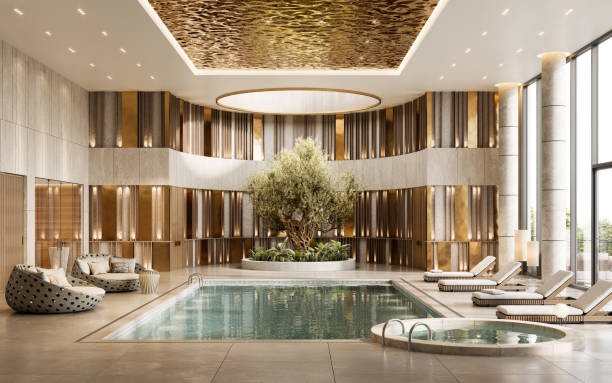Innovative Spa Designs: Elevating the Client Experience
In the competitive world of spa and wellness, the design and ambiance of a facility play a pivotal role in attracting and retaining clients. As spa-goers seek not just treatments but also a holistic experience that promotes relaxation and rejuvenation, spa owners are turning to innovative design elements to elevate the client experience. From sensory-enhanced treatment rooms to seamlessly integrated natural environments, these design innovations are transforming ordinary spaces into sanctuaries of health and well-being.
One of the most transformative design elements is the use of water features. The soothing sound of flowing water can be incredibly calming, making it a popular choice in spa design. Whether it’s a cascading waterfall at the entrance or gentle streams running through treatment areas, water features can significantly enhance the peaceful ambiance that is crucial for a relaxing spa experience. These features not only serve aesthetic purposes but also aid in the natural cooling of the environment, adding to the comfort of clients during their visit.
Lighting, too, plays a crucial role in setting the right mood and atmosphere within a spa. Soft, muted lighting helps create a tranquil environment that encourages relaxation. Innovative lighting solutions that adjust based on the time of day or the specific treatment being offered can tailor the experience even further, making each visit unique. Smart use of natural light, where possible, also adds a refreshing element to the overall spa experience, linking the indoor environment with the natural world outside.
Therapeutic scents and music are other critical components. A carefully curated selection of essential oils can be used to enhance the therapeutic effects of spa treatments, promoting deeper relaxation or rejuvenation, depending on the client’s needs. Similarly, background music chosen to complement the natural flow of the spa environment can significantly enhance the therapeutic experience, making sessions more effective and memorable.
An often overlooked but vital aspect of spa design is the layout and flow of the space. It is essential that clients move through the spa without feeling rushed or cramped. Spacious, thoughtfully arranged rooms that guide visitors through their spa journey can make a significant difference in their overall experience. This is where an architectural feature like a mezzanine floor can be particularly effective. Positioned above the main floor, a mezzanine can provide a secluded area for quieter, more private treatments or relaxation areas that overlook the rest of the spa, offering clients a literal and metaphorical elevation of their experience. Such design not only utilizes vertical space creatively but also adds an element of exclusivity and luxury to the spa’s atmosphere.
Furthermore, the physical materials used in spa design can influence how a space feels and functions. Natural materials such as wood, stone, and bamboo can create a sense of connection to nature, which is calming and grounding for many people. These materials are not only sustainable but also possess qualities that can enhance the acoustic properties of the space, contributing to a serene atmosphere that complements the soft music and whispered conversations often found in spas.
In addition to these sensory design elements, practical considerations are also key. For example, the placement of treatment rooms should ensure maximum privacy and quiet. Likewise, the accessibility of essential areas such as showers, saunas, and pools needs to be considered to provide a seamless experience. Efficient service areas for staff, including massage therapists, are also crucial. They require functional spaces to prepare and maintain a high standard of service, all while remaining unobtrusive to the relaxing spa environment.
A massage therapist’s workstation, specifically, should be designed to ensure they can perform their best work. Ergonomic considerations not only support the therapist’s physical health but also enhance the quality of the massage therapy provided. Well-designed stations reflect a spa’s commitment not only to the comfort of its clients but also to the well-being of its employees.
Ultimately, the goal of innovative spa design is to create an environment that enhances the physical and psychological benefits of spa treatments. By carefully considering each element — from the macro aspects of layout and flow to the micro details of sensory experiences — spa owners can craft spaces that not only meet but exceed the expectations of their clients, ensuring a tranquil, restorative experience that encourages repeated visits. Innovative spa designs do more than just serve functional and aesthetic purposes; they become integral to the healing and rejuvenation process, promising not only relaxation but a complete escape from the stresses of daily life.

